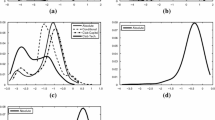Abstract
We study the role of different labor market integration policies on economic performance and convergence of two distinct regions in an agent-based model. Production is characterized by a complementarity between the quality of the capital stock and the specific skills of workers using the capital stock. Hence, productivity changes in a region are influenced both by the investment of local firms in high quality capital goods and by the evolution of the specific skill distribution of workers employed in the region. We show that various labor market integration policies yield, via differing regional worker flows, to distinct regional distributions of specific skills. Through this mechanism, relative regional prices are affected, determining the shares that the regions can capture from overall consumption good demand. There occurs a trade-off between aggregate output and convergence of regions with closed labor markets resulting in relatively high convergence but low output, and more integrated labor markets yielding higher output but lower convergence. Furthermore, results differ substantially in several respects as distinct labor market opening policies are applied.








Similar content being viewed by others
Notes
Again, these numbers were motivated by empirical observations in Germany and Poland.
This observation has been checked considering the dynamics of capital/output ratios, but we refrain from presenting the corresponding figure here.
References
Acemoglu D (2009) Introduction to modern economic growth. Princeton University Press
Aghion P, Boustan L, Hoxby C, Vandenbussche J (2009) The causal impact of education on economic growth: evidence from U.S. Harvard University, Mimeo
Barro RJ, Sala-i-Martin X (1992) Convergence. J Polit Econ 100:223–251
Bassanini A, Scarpetta S (2002) Does human capital matter for growth in OECD countries? A pooled mean group approach. Econ Lett 74:399–405
Boeri T, Bertola G, Brücker H, Coricelli F, Dolado J, Fitzgerald J, de la Fuente A, Garibaldi P, Hanson G, Jimeno J, Portes R, Saint-Paul G, Spilimbergo A (2002) Who’s afraid of the big enlargement? Economic and social implications of the European Union’s prospective eastern expansion, CEPR policy paper no. 7, CEPR London
Canova F, Marcet A (1995) The poor stay poor: non-convergence across countries and regions CEPR discussion paper no. 1265
Chiaromonte F, Dosi G (1993) Heterogeneity, competition and macroeconomic dynamics. Struct Chang Econ Dyn 4:39–63
Dawid H, Gemkow S, Harting P, Neugart M (2009) On the effects of skill upgrading in the presence of spatial labor market frictions: an agent-based analysis of spatial policy design. JASSS 12:4
Dawid H, Gemkow S, Harting P, Neugart M, Wersching K (2008) Skills, innovation and growth: an agent-based policy analysis. Jahrb Natlökon Stat/J Econ Stat 228:251–275
Delli Gatti D, Guilmi C, Gaffeo E, Giulioni G, Gallegati M, Palestrini A (2005) A new approach to business fluctuations: heterogeneous interacting agents, scaling laws and financial fragility. J Econ Behav Organ 56:489–512
Dosi G, Fagiolo G, Roventini A (2010) Schumpeter meeting Keynes: a policy-friendly model of endogenous growth and business cycle. J Econ Dyn Control 34:1748–1767
Dosi G, Marsili O, Orsenigo L, Salvatore R (1995) Learning, market selection and the evolution of industrial structures. Small Bus Econ 7:411–436
Griffith R, Redding S, van Reenen J (2004) Mapping the two faces of R&D: productivity growth in a panel of OECD industries. Rev Econ Stat 86:883–895
Growiec J (2008) Productivity differences across OECD countries. In: The World technology frontier revisited IBS working paper No.1/2008 institute for structural research, pp 1970–2000
Haber G (2008) Monetary and fiscal policy analysis with an agent-based macroeconomic model. Jahrb Natlökon Stat/J Econ Stat 228:276–295
Howitt P (2000) Endogenous growth and cross-country differences. Am Econ Rev 90:829–846
Islam N (1995) Growth empirics: a panel data approach. Q J Econ 110:1127–1170
Keller W (2004) International technology diffusion. J Econ Lit 42:752–782
Malerba F, Nelson R, Orsenigo L, Winter S (2001) Competition and industrial policies in a ’History-Friendly’ model of the evolution of the computer industry. J Ind Organ 19:635–664
Mankiw GN, Romer P, Weil DN (1992) A contribution to the empirics of economic growth. Q J Econ 107:407–437
Nelson RR, Winter SG (1982) An evolutionary theory of economic change. Harvard University Press, Cambridge
Silverberg G, Verspagen B (1993) Collective learning, innovation and growth in a boundedly rational, evolutionary world. J Evol Econ 4:207–226
Solow R (1956) A contribution to the theory of economic growth. Q J Econ 70:65–94
Tesfatsion L, Judd KE (2006) Handbook of computational economics II: agent-based computational economics. North-Holland
Wong K, Yip KC (1999) Education, economic growth, and brain drain. J Econ Dyn Control 23:699–726
Acknowledgements
We are gratefully to an anonymous referee and the editors of this special issues for helpful comments. This work was carried out in conjunction with the EURACE project (EU IST FP6 STREP grant 035086) which is a consortium lead by S. Cincotti (University of Genova), H. Dawid (University of Bielefeld), C. Deissenberg (Université de la Mediterrané), K. Erkan (TUBITAK National Research Institute of Electronics and Cryptology), M. Gallegati (Università Politecnica delle Marche), M. Holcombe (University of Sheffield), M. Marchesi (Università di Cagliari), C. Greenough (STFC - Rutherford Appleton Laboratory).
Author information
Authors and Affiliations
Corresponding author
Electronic Supplementary Material
Below is the link to the electronic supplementary material.
Rights and permissions
About this article
Cite this article
Dawid, H., Gemkow, S., Harting, P. et al. Labor market integration policies and the convergence of regions: the role of skills and technology diffusion. J Evol Econ 22, 543–562 (2012). https://doi.org/10.1007/s00191-011-0245-1
Published:
Issue Date:
DOI: https://doi.org/10.1007/s00191-011-0245-1




